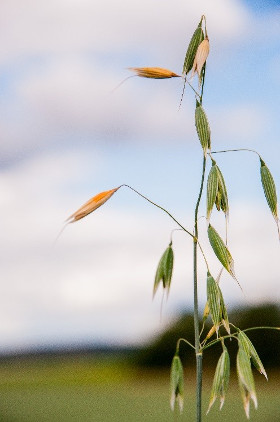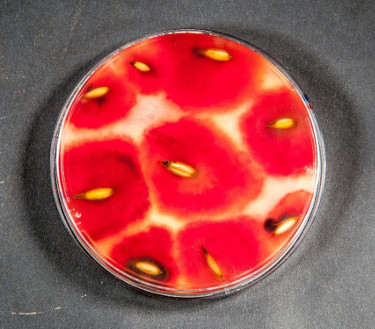 In order to identify products to be used for the control of Fusarium mycotoxins in small grain cereals, including control suitable for organic farming, two field trials of oats were conducted at the Norwegian Institute of Bioeconomy Research (NIBIO) in Norway summer 2016. One of the trials was inoculated with Fusarium graminearum infested oat grains. After a few weeks, a large amount of black perithecia (fruiting bodies of the fungus) were developing on the infested grains, just in time to spread F. graminearum ascospores to the oat flowers. The weather at oat flowering was warm and rainy, which gave perfect conditions for the development and dispersal of F. graminearum ascospores, and further for the infection and development of Fusarium mycotoxins in oats. After flowering, salmon coloured sporodochia of F. graminearum were observed on some of the oat spikelets (Picture 1).
In order to identify products to be used for the control of Fusarium mycotoxins in small grain cereals, including control suitable for organic farming, two field trials of oats were conducted at the Norwegian Institute of Bioeconomy Research (NIBIO) in Norway summer 2016. One of the trials was inoculated with Fusarium graminearum infested oat grains. After a few weeks, a large amount of black perithecia (fruiting bodies of the fungus) were developing on the infested grains, just in time to spread F. graminearum ascospores to the oat flowers. The weather at oat flowering was warm and rainy, which gave perfect conditions for the development and dispersal of F. graminearum ascospores, and further for the infection and development of Fusarium mycotoxins in oats. After flowering, salmon coloured sporodochia of F. graminearum were observed on some of the oat spikelets (Picture 1).
 Grains harvested from this field are now being analysed. Almost 100% of the oat grains harvested from the untreated control plots were infested with F. graminearum (Picture 2). In order to study the effect of the different treatments, the mycotoxin deoxynivalenol (DON) will be quantified in oat grain samples harvested from all the field plots.
Grains harvested from this field are now being analysed. Almost 100% of the oat grains harvested from the untreated control plots were infested with F. graminearum (Picture 2). In order to study the effect of the different treatments, the mycotoxin deoxynivalenol (DON) will be quantified in oat grain samples harvested from all the field plots.
